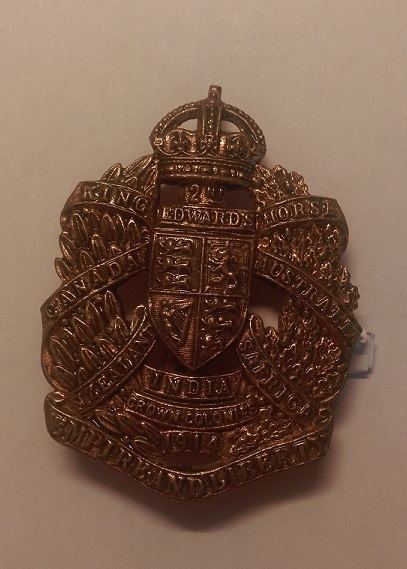Active 1901–1924 | ||
 | ||
King Edward's Horse (The King's Overseas Dominions Regiment) was a cavalry regiment of the British Army, formed in 1901, which saw service in the First World War.
Contents
Early history
The regiment was originally formed as part of the Imperial Yeomanry in November 1901, as the 4th County of London Imperial Yeomanry (King's Colonials), with the Prince of Wales (later King George V) as honorary colonel. It was composed of four squadrons of colonial volunteers resident in London - one of Asians (British Asian Squadron), one of Canadians (British American Squadron), one of Australasians (Australasian Squadron), and one of South Africans and Rhodesians (British African Squadron). A New Zealand squadron was later formed, with the Australasian squadron being redesignated as Australian. It did not see service in the South African War. In 1905 it was retitled The King's Colonials, Imperial Yeomanry, and in 1908 became part of the Yeomanry in the Territorial Force. In 1909 the specific affiliations of the squadrons ended. With the death of Edward VII, after whom it had been named, it was retitled King Edward's Horse (The King's Overseas Dominions Regiment) in 1910. In 1913, it was transferred into the Special Reserve, and ceased to be considered yeomanry.
First World War
On the outbreak of war in 1914, the regiment was mobilised in London, where it remained until April 1915; at this point, the regiment was dispersed, and the four squadrons were sent to the Western Front with separate divisions. They were reunited in June 1916, the regiment serving as corps troops, and moved to Italy in December 1917. The regiment returned to France in March 1918, serving until the end of hostilities. Some reports suggest that the final British casualty of the war was a private in C squadron.
A second regiment, 2nd King Edward's Horse, was raised in 1914 by John (later Sir John) Norton-Griffiths, at his own expense. The original regiment was subsequently known as 1st King Edward's Horse. The 2KEH was disbanded in August 1917 with many of its members being transferred to the Tank Corps.
King's Colonials Lodge
The Regiment was disbanded in March 1924, and both it and its comrades' association have ceased to exist. However, in 1909 the Regiment officially sanctioned and formed a regimental masonic lodge, the King's Colonials Lodge No 3386, in London. As the number of surviving members of the closed regiment dwindled, they opened membership of the regimental Lodge to all interested persons, and passed all regimental traditions to the Lodge. The Worshipful Master of the Lodge has an official entitlement to wear the regimental tie (now the only living person with that entitlement), and the Lodge became the custodians of all regimental property, including regimental silver valued at many thousands of pounds. The Lodge continues to function, and to maintain regimental traditions. The regimental property is stored by the Lodge in a secure vault at Haileybury College. The Lodge continues to tend regimental graves, and to lay wreaths at the regimental memorials in London and France.
Honorary Colonel
Lieutenant-Colonel and in command
Battle honours
The Great War: Loos, Ypres 1917, Pilckem, Cambrai 1917, Lys, Estaires, Hazebrouck, Pursuit to Mons, France and Flanders 1915-16 '18, Italy 1917-18
